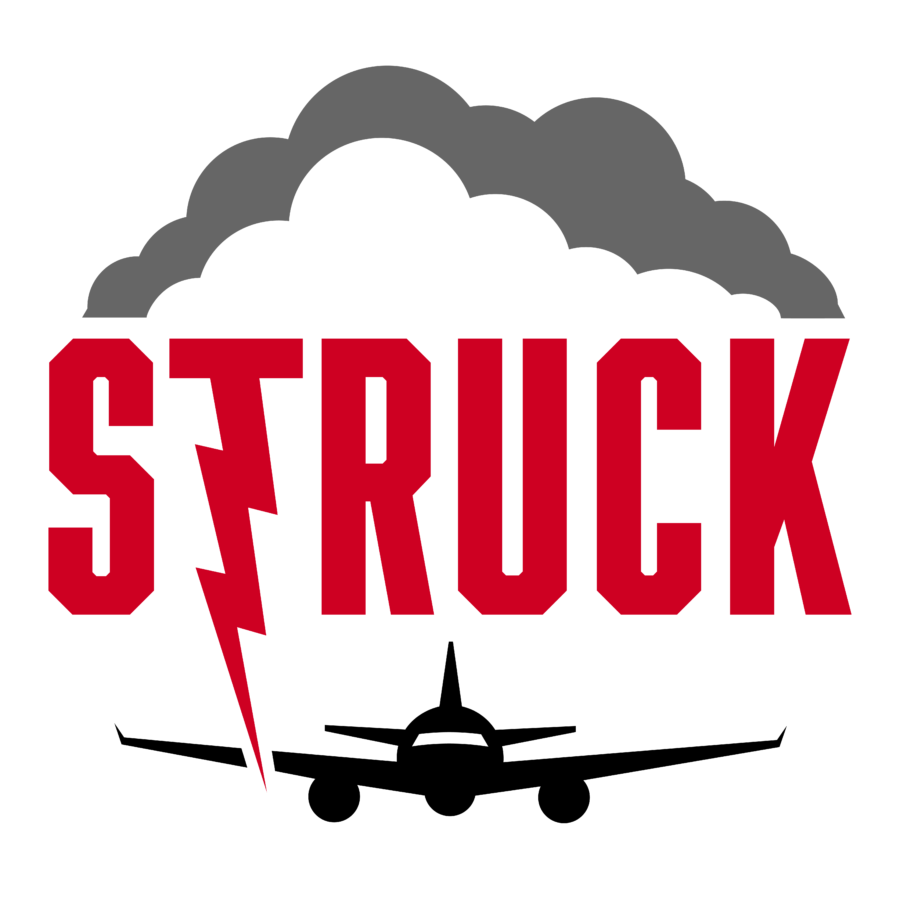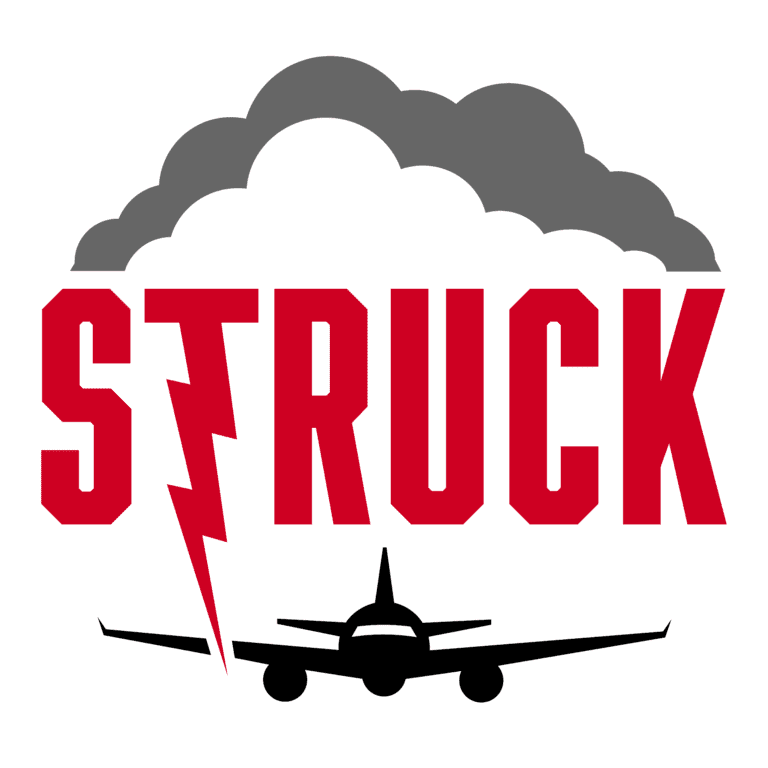As the COVID-19 pandemic continues, Allen and Dan discuss the impacts on the aircraft industry and the internal workings of aircraft companies. How many aircraft OEMs will survive this world-changing struggle?
Learn more about Weather Guard StrikeTape segmented lightning diverter strips. Follow the show on YouTube, Twitter, Linkedin and visit us on the web. Have a question we can answer on the show? Email us!
Podcast: Play in new window | Download
Transcript
Dan: Welcome back! This is episode 4 of the Struck Podcast. I’m your co-host DanBlewett and I’m here joined remotely by lightning protection expert Allen Hall. Allen, how are you doin?
Allen: Great Dan, how are you doin’ down in Washington DC?
Dan: I am doing well. It’s been beautiful the last couple days. It was almost eighty degrees yesterday. And so it’s really nice out now but pretty windy. I think I want to probably get a run in after the podcast is over. But yeah it’s still, the ghost town which I think is the right thing to do. But how’s
Williamstown doing? Is it warming up there yet?
Allen: No. In fact your wind storm is our snowstorm. It’s supposed to snow tonight between one and three inches. So tomorrow would have been a snow day for the kids not to go to school, but obviously, they’re home already. So that’s out the window. But we have not reached spring yet. We’re still a couple good weeks away from real spring.
Dan: Yikes.We’re–you know as we talked about– weeks away from anything right now. There’s only one thing we’re all wondering how many weeks away it is which is when does this whole thing start to end. Got any predictions?
Allen: I think we’re talking about middle May. And just listening to some news last night and some airline talk over the last couple of days, it seems like in at least the United States you may see some activity and some people returning to work and being a little more productive. Starting in May and then it slowly gradually increases where we bring people back and get things going again. I was just at one of our customers’ facilities earlier today and there was roughly twenty percent of the people there. And it’s been that way for a couple of weeks but they’re also thinking maybe next week a couple more people can come back. Not huge percentages. But as things have leveled out, at least around us, they’re probably gonna bring some of them back.
Dan: Yeah. So as we check up on the airline industry, there are a couple new news stories just recently. So Boeing and Airbus are both closing some factories down at least temporarily. You know Airbus in Alabama they’re not laying off their employees, they’re gonna have their jobs back it sounds like. But they’re just heading home for right now. So they are furloughed I guess. And then Germanwings which is the low-budget airline from Lufthansa overseas sounds like they’re shutting them down for good and just sort of consolidating with their overall bigger brand. Do you expect more of this?
Allen: Too many airplanes
Dan: Yeah. I mean is this a…I was listening to another podcast earlier today and they were talking about auto industry brands. And that at one point there were a hundred ten different auto manufacturers. Brands like Chrysler, Ford, Jeep. And like economic downturns like this can sort of just eliminate some of the ones we don’t need necessarily. Do you feel like that’s happening here in aviation?
Allen: Yeah. Downturns have predicted winners and losers. If you have enough cash stored away and you have an ability to quickly scale back up, you’re gonna be a winner. If you don’t you’re going to be gone. And you saw that in the aircraft industry in the United States through if you look into the late 60s and the early 70s. There was a lot of small aircraft manufacturing–a lot of more aircraft manufacturing. Douglas Aircraft, McDonnell Douglas is still around. Yeah. There was a lot more aircraft manufacturers. A lot of them were leftover from sort of World War 2 era. And as the economy went bad and the oil prices shot up, those industries collapsed. And so there’s a lot of those smaller aircraft companies that got consolidated and some of the big ones merged over time. It’s a common occurrence. The thing that we’re looking for now is that some of the other players that were sort of mid-sized, do they become bigger? Do the Embraer’s become bigger? Or do the you know…Bombardier has become smaller recently because of their financial restructuring. Hopefully they can make it through this bad period. And that’s one of the companies that’s probably on the bubble right now, unfortunately. So it’s sometimes just bad timing that plays into this. There’s really not a lot of predictability in this particular case. It isn’t like you could see a World War 1 or World War 2 coming about and prepare for it. This is something that has been unexpected. So if your company was shaky to begin with, it may be a struggle to get back out. Hopefully the governments step in a little bit. Hopefully the Canadian government steps in with Bombardier, they have already, and really kind of provide some security around that. This is thousands of thousands of highly technical jobs. You really don’t want to lose them because it’s gonna be hard to recreate them.
Dan: Yeah. So I’ve got another article here pulled up and it’s about parts manufacturers. And there’s an interesting quote where one of these executives says “We don’t earn money on the first installation on a new plane, but on the life of our products over 20 years. If planes don’t fly, we don’t sell spare parts and our products don’t create a need for maintenance”. So speak a little bit on the parts. ‘Cause everyone’s talked about airliners right now. Everyone’s thinking about Boeing and Airbus, the manufacturers, but also Southwest and United and American, the big airlines. But talk about the parts. ‘Cause how many parts are in an aircraft? Like a million?
Allen: Thousands
Dan: Some crazy huge number. So how is that affecting that industry?
Allen: The parts manufacturers have, a lot of them,have shut down and closed. They did that about a week or so ago where there was just no demand for product. And they had stocked the shelves enough where they had enough of a buffer. I think there’s just sort of two plays into that right now. First is that the number of airplanes that are going to be coming back online is going to be as many as when they shut down. So we’re gonna be probably at 50%, 75% for a while in terms of number of airplanes that are flying. So the repair mark it’s going to be slower also. You’re gonna be selling 50 to 75% of what you were usually selling in terms of repair parts. It has a real trickle down, people don’t like that term, but it is what it is in aircraft. There’s a trickle-down economy in aircraft which is how Boeing goes, how Airbus goes, how some of the big players go. There are thousands and thousands and thousands of people behind that that are providing parts not only to Boeing and Airbus but also in the aftermarket side. That really hurts. And obviously Boeing and Airbus also have strong aftermarket sales where they’re selling parts to repair their aircraft. And so do the powerplant makers, the Pratt & Whitney’s that are Rolls Royces of the world. They also are selling parts like that on the aftermarket. It really hurts because it’s true. A lot of their profitability comes from selling parts and support after the sale of the aircraft. It’s very similar to the way you bought a car back in the 1970s or 80s. There was a real connection between you and the automotive manufacturer. So if I purchased a Ford, I was probably going to– a lot of people did–probably went to go buy Ford repair parts. Authorized Ford repair parts, not just generic parts for it. Aircraft tend to be more in that model still. So there’s a big profit margin center there that needs to be fed to keep the airlines running and also to keep the aircraft manufacturers profitable.
Dan: Gotcha. That makes sense and you wonder sometimes what the economics is. Prices over the years keep getting pushed lower and lower as there’s more and more competition. And that’s where you think like yeah a lot of these companies are probably making it up on the back end. Again like over the life of a car that maybe they’re trying to make a little more affordable but they know they’ll sell more radiators or whatever down the road. So that makes sense.
Allen: It was very common, having worked for a number of aircraft and business aircraft manufacturers, that when they contracted out for a supplier to provide a component for the aircraft, that the aircraft manufacturer wasn’t paying full price for that part in a sense. The aircraft manufacturers would really push down on pricing and make the aircraft component supplier participate as a “partner” even if it wasn’t a great financial partnership. Because the aircraft manufacturers tended to pay for all the non-recurring expenses, which means the engineers that are at the supplier… they used to basically pay for engineers to design the thing and cover all the testing costs. That seemed to be part of it. But the actual purchase of the component was driven down a lot in the thought that a supplier would make it up on quantity. That this product would be going on for 30 years, they’d be building replacement parts for the next 50 years. So they were looking way down the line and becoming profitable. And it’s really hard to do that. If there’s an aircraft program that exists right now that’s going through certification, it can be hard for them to conceptually say–with the downturn–I’m gonna delay my payment period. It’s gonna get shoved off to the right a year or more. The economics get really funky when that happens. And a lot of suppliers will go back to the aircraft manufacturer to say hey look this is no longer an even remotely profitable thing for us. We’re just breakeven or losing money. And they’ll bail. They’ll just stop work until the aircraft manufacturers either throw them some cash or renegotiate. So there’s gonna be a lot of horse-trading. There’s gonna be a lot of horse trading going on from those lower level suppliers and the tier-two, tier-three suppliers, all up to the tier-one suppliers. They’re all going to be renegotiating and trying to get back to profitability because the economic models they had really just got thrown out the window.
Dan: Yeah that makes sense. So you and I were talking off-camera a little bit about testing some of these new parts. Whether it’s against lightning strikes or otherwise and trying to find the balance between under-testing and over-testing. And over building under building. Can you speak a little bit about that and how these parts manufacturers can find the balance?
Allen: Yeah. So I always try to frame it let’s look at what the safety requirements are and let the requirements then flow down to what we need to go do. A lot of times when a company calls us and says hey we’ve got a component we need to go test it, the first thing I asked was well okay what does it do? And then what role does it play in the aircraft? If it doesn’t perform correctly, does it crash the airplane or is it just a nuisance? What level of criticality you have assigned to this thing. And it’s surprising a lot of times…I bet it’s probably 75% to 80% of the time right now the engineer that’s designing the equipment doesn’t really know what the criticalities and the functions that that piece of equipment provides. So I’ll say hey go back and look. Somebody in your organization has defined it. Usually, it’s a reliability person that has created a hazard assessment, what we call a functional hazard assessment. That just says if this box does X, here’s the result and this is what effect it has on the aircraft. Everything else after that is how we test it or how we design it and test it. So if a component can go wrong and crash an airplane, we would define that –in the lightning world we define it–as a level a piece of equipment or level a system. And then we go off and run certain tests to make sure that that doesn’t happen. And even at certain lightning levels. So the lightning levels, particularly for electronic boxes, will change based on the criticality. So there’s a consequence to all that. And a lot of times the engineers will say well the box just has to work. It can’t have any upsets. Can’t go wrong, can’t fail passive. It’s just got to work all the time. Well that’s great. I mean that’s a great sort of first cut design philosophy, that it should work. Yes I’ll grant you that but that means there’s gonna be added cost-weight complexity added to that piece of equipment if you don’t need it. And so it’s a better path to look at what the criticalities are, what the functions are. Look at the overall design from that standpoint and then come in and design it. And then come in and test it. It’s gonna save bucket loads of money and countless hours of engineering time if we do that. Sort of first look at it from the safety standpoint. And what we’re seeing right now, what I see a lot of, is the engineers just don’t know ’cause they haven’t really been through that process before. And it does result in less expensive, more efficient designs if we take a look at the criticality.
Dan: Yeah I mean that makes sense. So what do you think…to improve this in the industry going forward, what systems need to be put in place? Or do they need more personnel that can sort of help with this? Or what do you think needs to happen?
Allen: So here’s–at least over the last 10-15 years here’s what tended to happen. There would be a reliability group of very smart people and very studious people that are looking at failure modes of how this piece can go wrong and then creating these fault trees and analysis and generating all this paperwork. They were usually tossed into a corner somewhere and no one talked to them. So they were kind of self-isolating. No one wanted to go over there because there’s just a very unique personality to go do that work. But they are the start of every aircraft program. And I always used to say okay time out. We need to go talk to reliability people and figure out what’s going on. And it was amazing what the reliability groups could tell us about how the way that aircraft was supposed to operate. It made our life so much easier. And I think from a design standpoint a lot of times, on this particular electrical side, we need to kind of get out of our own cubicles and walk over to the reliability side. And say hey what am I doing here. What do I need this for? And sometimes even push back on things. Sometimes the reliability people are under conservative, over-conservative. They haven’t thought about particular ways that the system may work or may not work that need to get incorporated into their work. So it’s kind of a little bit give-and-take. But I always think in today’s world, the fastest thing to do is to talk to a reliability engineer and get the lowdown from them. There’s SAE documents, there’s plenty of SAE documents and some FAA documents that sort of walk through that process. But they’re thick and they’re complicated. Just very complex language in them so for the novice, there’s just no way to grasp what’s going on. And so I use the reliability engineer as the translator between SAE, FAA lingo to human. And that’s the way I always looked at it. So yeah I think in today’s world, I think this can be interesting to see what happens on the 737 max. Because I do think one of the areas, where they struggled, was design engineer or flight test engineer to reliability person. Was that connection always there?
Dan: Yeah and that makes sense. And that’s what I’ve been wondering and you know I’ve chatted about that as well which is that everyone seems to have very specialized jobs within the aviation industry. You can’t be expected to be an expert on avionics versus this verses that versus lightning or anything else. So how do you guys sort of communicate between each other? I mean is that a big rampant problem?
Allen: It’s clique-ish. I would say it’s clique-ish. The electrical engineers tended to hang out with electrical engineers. Pilots are definitely hanging out with pilots. Pilots don’t usually talk to anybody besides maybe power plant engineers.
Dan: Yeah stay away, nerds.
Allen: Right yeah. Back off nerd.Yeah it’s very clique-ish. It’s sort of high school-ish in a sense. In a professional high school. Everybody’s a professional. It isn’t like there’s huge personality differences. You know flight test engineer and a pilot quite honestly. There’s not much different in personality from the mechanical engineer, designing some component. But because they wear a blue flight suit, the flight test people stand out and are their little club over there. I think the key for management and particularly chief engineers– and a lot of times there aren’t any chief engineers and some of these programs but there should be–the chief engineers are there to kind of kick those doors down. And yank key people into the room. I’ve noticed that a real driver on successful aircraft programs is pulling in–and I always say it’s roughly a dozen people. Maybe on a larger aircraft program it’s probably more but the overall direction, the overall design, the overall performance of an aircraft can be done in a room with about 12 people. 12 different design sections so to speak. Like your dynamics, environmental, control systems, electrical, power, avionics. So you can kind of break them down into normal groups there. But it’s about 12. If you get 12 really good people who know their stuff, they also tend to know how they interact with the other 11 around the table. If those 12 people were all together and are the best you can find, the aircraft will do just fine. You get to certification and get it done. If you have holes in that group, what I have seen is aircraft struggle to get done. You just need—it’s similar to what I’ve been watching lately which is some of the original work building some of the Apple computer stuff. And it’s essentially, even with Apple today, they get a room full–when I say room full maybe 10 or 20 people tops–of really smart people in their particular aspect. And they just jam them all together and say work it out. It does make a difference when they do that. If they don’t talk to one another, which I’ve seen it more recently in some of these aircraft companies, I don’t think the airplane is as efficient. If they make it to certification, I don’t think the aircraft is efficient or as good a performer as it could have been. That’s the difference
Dan: Yeah and this kind of reminds me…So I was reading up aboutBoeing and some other 737 problems and I guess when they were bought by–were they bought or were they bought out– McDonnell-Douglas and so they were used to doing everything essentially in-house prior to them. Boeing controlled pretty much everything in their little ecosystem and then suddenly the new CEO says well we can lower costs. We can do things a lot differently and…
Allen: We can do it the McDonnell-Douglas way.
Dan: Yes exactly. And suddenly they’re getting parts from all over the world and they’re having communication problems. And they suddenly went from a company that never missed deadlines, that was a mortal sin for Boeing to miss a deadline, to missing deadlines by a year, you know 18 months. So is that sort of like the climate now? I mean are planes… is that just how they’re manufactured today? Just pieced together from throughout the world?
Allen: They are but it also depends on where the strengths are. And a lot of it today is still who you have worked with in the past and then putting them on the new program. So if you’ve been successful with a company on a previous project, you’re gonna drag them onto the next project sort of thing. So there tends to be history that way. I don’t think… So I think you raise a really good point. And the point is at what point you have a really good system in place and then you bring in outside and it kind of goes away. I’ve watched that happen because aircraft companies have merged over time. I’ll give you one example. My first example of this is when Beech Aircraft was acquired by Raytheon and then later sold by Raytheon. The cultures were just totally different. Raytheon was making dishwashers and missiles and a whole variety. They were like the kind of a GE type of corporation. And they bought an aircraft company. And I’m not even sure why they bought it. But they bought it and it was really just two different cultures coming together. Raytheon being based on the East Coast, Beech aircraft always being in Wichita, Kansas. There are differences in personalities and way people get things done and the way they communicate to one other on the East Coast versus this sort of…the heartland. That led to a culture shock between the two and it just never really clicked. Not to say anybody was wrong in that situation, I don’t think so. Obviously it comes down to personalities at the end. But tying together two different cultures like that–and I’m not saying that culturally speaking like country speaking, but just two different ways that companies have organized. When you mash two of them together or one eats the other, it’s hard. It’s really hard to change the way things have been in place for– and Beech Aircraft had been in place for 50 years or more–it’s really hard to change that culture with something else. It would be very similar… It’d be very similar to you know a high-tech company buying an automotive company, right. So if Tesla bought General Motors, talk about culture shock. I mean those two would never ever be able to come together that way because they just think about the world differently. They see things out of a different lens. That’s what it was like when Raytheon and Beech were kind of going at it.
Dan: Yeah I mean that seems like a really big struggle for all sorts of companies. I mean you saw it on The Office. You know, the popular television show.
When the two branches combine…
Allen: ‘Cause you know, I mean even the writers have seen it, right. So I always…when we see The Office once in a while, Ialways think man it seems like they’re pressing it. But they just have a pulse on culture. That sort of thing happens all the time where one company to another. That’s in there, just that culture clash. And it creates a lot of tension and obviously it creates comedy. When you’re in it it’s not comedy. It’s a lot of sleepless nights one like man how are we ever going to do this and there’s really I haven’t seen a lot of other ways to do it my take on it is look if you’re going to if you’re going to buy a company man you’ve gotta just bite the bullet. Change the culture. Get rid of people who don’t go along with it and move on. You can’t let it linger. You can’t drag it on for 10 years in the hopes of like… it’s either we’re all in this together, or get out. Because we don’t have time to waste time. We just don’t have it. We don’t have any money to burn here. That’s what it’s like. That’s what it should be like.
Dan: Yeah, for sure. I think that’s a huge challenge in any business. Any size business.I mean you’ve got different leadership styles. And you know I’m sure you’ve been through it. And all of us have friends who like get a new job and it seemed great and then they just like don’t get along with key managers or key players down there. It’s just… the office is just a struggle until they can find a good fit. And then you start trying to do that mashing 2,000 person or more companies together. It can be pretty crazy.
Allen: It’s brutal. It’s brutal, it’s brutal. I don’t know if I’ve ever seen it work very successfully. I just really haven’t seen it done very successfully. The ones that have had a chance at it are the ones that come in or a kind of cutthroat. Like all right, this is the direction we’re going. Whoever doesn’t want to be here, get out. And you know have a nice life. That’s brutal to kind of watch that go on. I was involved in one of those. That’s brutal to watch on ’cause good people you know like dang that guy is good or that engineer is talented. And they’re walking out the door. We can’t really afford that. But I think at the end of the day, what you kind of come to the conclusion of is pretty much everybody’s replaceable. You’ve just got to get the right personality in the slot.
Dan: And probably when a company buys…like say you know a big company buys like an offshoot company. Like Amazon buys a specialty manufacturer like doorbell technology. Maybe they leave that company kind of alone. You know like they don’t have to fold them into their regular thing and let them kind of coexist. Like we own you, but you can have your own house still. You can have your own apartment still. And slowly bring you in. That seems like that works a little better sometimes.
Allen: Yeah. I lived through one of those where the company was acquired and they were told hey you’re making good money, you’re a corporation, that’s a reason that we bought you. We’re gonna leave you alone. Okay, yeah, that did sort of happen. But then you know other parts of the company struggle, they’re sucking money out of the corporation and they want to suck more… Not suck money, they want to pull more money out of the corporation and they wanted more money out. And all of a sudden they see this cash engine machine going on. And then you want to grab hold of it because it’s profitable. So no matter what you do and I mean unless the CEO has come down and said you shall not touch this little company over here, it’s going to get tampered with. It has to because there’s too many personalities that are driving that ship. They will start touching it, they have to.
Dan: Yeah it’s like–I’m on pop culture quote today but –in the Arrested Development, he always says “well there’s always money in the banana stand”. A little profitable thing that you can always tap into.
Allen: Be by yourself, right? Yeah. No one’s gonna bother you, yeah.
Dan: Well on that note, I think we’re gonna sign off for today. So yeah, thank you for listening today. Obviously this is the Struck Podcast. We are sponsored by Weather Guard Lightning Tech, so if you need anything, if you’re a radome designer, if you’re interested in learning more about how to protect your aircraft, Definitely check us out at www.weatherguardaero.com. Check out our YouTube channel here where you’ll see video replays of all of our podcasts, including great short clips. If you need just like a quick hit of information, we have tons of those. And then be sure to subscribe, to share the show with a friend, and tune in here next week! Allen, thanks so much for being here!
Allen: Yeah, thanks Dan! We’ll see you next time!
Dan: Take care!












